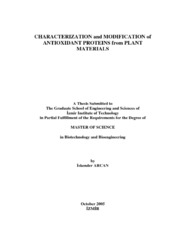Please use this identifier to cite or link to this item:
https://hdl.handle.net/11147/3234Full metadata record
| DC Field | Value | Language |
|---|---|---|
| dc.contributor.advisor | Yemenicioğlu, Ahmet | - |
| dc.contributor.author | Arcan, İskender | - |
| dc.date.accessioned | 2014-07-22T13:51:09Z | - |
| dc.date.available | 2014-07-22T13:51:09Z | - |
| dc.date.issued | 2005 | - |
| dc.identifier.uri | http://hdl.handle.net/11147/3234 | - |
| dc.description | Thesis (Master)--İzmir Institute of Technology, Biotechnology and Bioengineering, İzmir, 2005 | en_US |
| dc.description | Includes bibliographical references (leaves: 73-75) | en_US |
| dc.description | Text in English; Abstract: Turkish and English | en_US |
| dc.description | xiv, 92 leaves | en_US |
| dc.description.abstract | In this study, the radical scavenging and iron chelating capacity of proteins from heat treated (20 min at 90 oC) or thermally processed (20 min at 121 oC) chick-peas andkidney-beans were compared. Lyophilized crude protein extracts from chick-peas contained more protein (1.5-3 fold) and showed higher free radical scavenging (up to 2.3 fold) and iron binding capacity (up to 3 fold) than lyophilized crude protein extracts form kidney-beans. The thermal processing of chick-peas did not cause a significant change in the radical scavenging capacity of their lyophilized crude protein extracts, but improved the iron chelating capacity of these proteins almost 80 %. However, the thermal processing reduced both the radical scavenging and iron binding capacity of crude lyophilized proteins form kidney beans by 20-40 % and 60 %, respectively.Partial purification by ammonium sulfate precipitation or DEAE-cellulose chromatography increased the antioxidant capacity of thermally processed chick-pea proteins. The DEAE cellulose chromatography also showed the presence of 5 and 3 antioxidant protein fractions in heat treated and thermally processed chick-peas, respectively. Hot acidic hydrolysis at 80 oC for 30 min in presence of 1.5 M HCl increases the specific antioxidant activity of protein extracts, but causes the formation of undesired Maillard reaction products. Hot extraction at 85 oC for 30 min at pH 2.5 extracts the antioxidant proteins selectively, whereas 85 oC for 30 min at pH 9.5 extracts both antioxidant proteins and other proteins. | en_US |
| dc.language.iso | en | en_US |
| dc.publisher | Izmir Institute of Technology | en_US |
| dc.rights | info:eu-repo/semantics/openAccess | en_US |
| dc.subject.lcsh | Proteins | en |
| dc.subject.lcsh | Proteins--Purification | en |
| dc.subject.lcsh | Antioxidants | en |
| dc.title | Characterization and Modification of Antioxidant Proteins From Plat Materials | en_US |
| dc.type | Master Thesis | en_US |
| dc.institutionauthor | Arcan, İskender | - |
| dc.department | Thesis (Master)--İzmir Institute of Technology, Bioengineering | en_US |
| dc.relation.publicationcategory | Tez | en_US |
| dc.identifier.wosquality | N/A | - |
| dc.identifier.scopusquality | N/A | - |
| item.openairecristype | http://purl.org/coar/resource_type/c_18cf | - |
| item.languageiso639-1 | en | - |
| item.openairetype | Master Thesis | - |
| item.grantfulltext | open | - |
| item.fulltext | With Fulltext | - |
| item.cerifentitytype | Publications | - |
| Appears in Collections: | Master Degree / Yüksek Lisans Tezleri | |
Files in This Item:
| File | Description | Size | Format | |
|---|---|---|---|---|
| T000370.pdf | MasterThesis | 1.07 MB | Adobe PDF |  View/Open |
CORE Recommender
Page view(s)
228
checked on Mar 31, 2025
Download(s)
78
checked on Mar 31, 2025
Google ScholarTM
Check
Items in GCRIS Repository are protected by copyright, with all rights reserved, unless otherwise indicated.